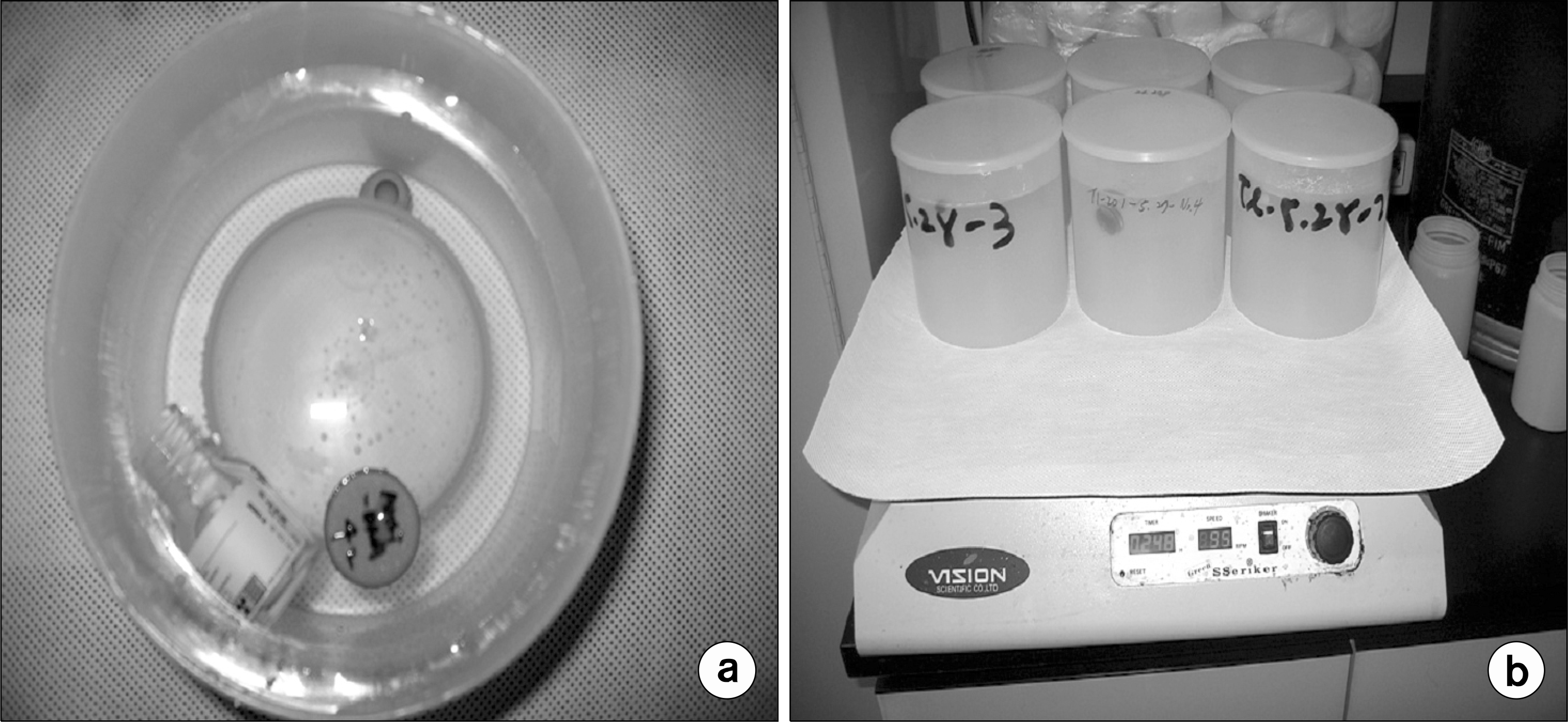Abstract
The amounts of radioactive wastes to be disposed in the medical institute have been increased due to development of radiation diagnosis and therapy rapidly. They are produced mostly by the very short lived radioisotopes such as 18F used in PET/CT, 99mTc, 123I, 125I and 201Tl, etc. IAEA proposed a criteria for the clearance level of waste which depends on the individual (10μSv/y) and collective dose (1 man-Sv/y), and concentration of each nuclide (IAEA Safety Series No 111-P-1.1, 1992 and IAEA RS-G-1.7, 2004). Radioactive wastes of 18F, 99mTc, 123I, 125I and 201TI in the several types of container like Marinelli beaker, vial and plastic, were collected to measure the concentration of the waste of each nuclide in accordance with IAEA criteria. The measurement method and procedure of determining specific activity of the wastes using gamma emitters like MCA, gamma counter and beta emitters were developed. For the efficiency calibration of the detectors, CRM (certified reference material) which has the same dimension and shape was provided by Korea Research Institute of Standards and Science (KRISS). Correction factor of the radioactivity decay was calculated based on the measurement results, and the consideration of mutual relation with theoretical equation. The result of this study will be proposed as ISO standard.
Go to : 
REFERENCES
1. Park JK, Kim SK, et al. Enhancement of the Early/Precise Diagnosis Based on the Measurement of SUVs in F-18 FDG PET/CT Whole-body Image. J Korean J Med Phys. 24(3):176–182. 2013.

2. Kim SJ, Han EO. Changes in External Radiation Dose Rate for PET-CT Test Patients. J Radiation Protection. 37(2):103–107. 2012.

3. Shapito J. Radiation Protection: A guide for scientists, regulator and Physicians. 4th ed. Harvard University Press;2002. ), pp.p. 359–371.
4. IAEA Safety Series No.40. Applying Radiation Safety Standards in Nuclear Medicine. 2005.
5. Ravichandran R, Binukumar JP, Sreeram R, Arunkumar LS. An overview of radioactive waste disposal procedures of a nuclear medicine J Med Phys. 36(2):95–99. 2011.
6. IAEA Safety Series No.111. Classification of Radioactive Waste. 1994.
7. IAEA TECDOC-1183. Management of radioactive waste from the use of radionuclides in medicine. 2000.
8. IAEA Safety Series No.111-P-1.1. Application of exemption principles to the recycle and reuse of materials from nuclear facilities. 1992.
9. IAEA Safety Guide RS-G-1.7. Application of the concepts of exclusion, exemption and clearance. 2004.
10. http://www.nssc.go.kr/nssc/information/law4_4.jsp. The code of nuclear safety and security commission Jae2012-59Ho:. Regulation for the clearance of radioactive waste. 2012.
Go to : 
 | Fig. 1.The photographies of Marinelli beaker containing the radioactive waste from nuclear medicine department. (a) Marinelli beaker with radioactive wasted container and saline solution, (b) the dissolution and diffusion of radioactive nuclide in saline solution using a stirrer. |
 | Fig. 2.The photography of various CRMs for the efficiency measurement of various measuring containers and the detection system. |
Table 1.
Radioactivity measurement according to the incident types of 18 F radioactive waste.
Table 2.
Radioactivity measurement according to the incident types of 99m Tc radioactive waste.
Table 3.
Radioactivity measurement according to the incident types of 123I radioactive waste.
Table 4.
Radioactivity measurement according to the incident types of 201Tl radioactive waste.
| Radionuclide | Tl-201 | ||
| Type of radioactive waste | Syringe cotton ball | Syringe (3 ml+3 Way) | Syringe (10 ml+3 Way) |
| No. of sample (n) | 4 | 6 | 3 |
| Specific radioactivity (Bq/g): m±σ | 1.65×105±2.51×105 | 4.31×105±2.30×105 | 4.64×104±2.52×104 |
| Radionuclide | Tl-202 | ||
| Type of radioactive waste | Syringe cotton ball | Syringe (3 ml+3 Way) | Syringe (10 ml+3 Way) |
| No. of sample (n) | 4 | 6 | 3 |
| Specific radioactivity (Bq/g): m±σ | N/A∗ | 1.00×104±2.07×104 | 1.52×102±9.40×101 |
| (Mean) storage period to clearance level (day) | - | 80.03 | 11.45 |
Table 5.
Radioactivity measurements according to the incident types of 125I (in vitro) radioactive waste.
| Type of sample | No. of sample (n) | Specific radioactivity (Bq/g) | (Mean) storage period to clearance level (day) | ||
|---|---|---|---|---|---|
| Mean±SD∗ | Max. | Min. | |||
| T3 | 100 | 51.6±27.1 | 130.2 | 5.6 | 0 |
| T4 | 100 | 44.5±24.3 | 94.3 | 10.0 | 0 |
| TSH | 100 | 20.5±51.1 | 282.8 | 0.2 | 0 |
| FREE T4 | 100 | 56.9±27.0 | 140.9 | 6.6 | 0 |
| Anti-TG | 100 | 11.7±22.3 | 114.3 | 0.5 | 0 |
| Anti-TMS | 100 | 34.4±24.1 | 83.8 | 1.4 | 0 |
| TG | 100 | 15.2±52.1 | 315.2 | 0.1 | 0 |
| CEA | 100 | 21.1±47.5 | 208.1 | 0.4 | 0 |
| CA19-9 | 44 | 23.8±52.7 | 262.4 | 1.3 | 0 |
| LH | 54 | 18.6±39.5 | 187.7 | 0.3 | 0 |
| FSH | 54 | 16.9±34.1 | 171.3 | 1.2 | 0 |
Table 6.
Types of radioactive waste sample occurred from the in vitro examinations of 125I.




 PDF
PDF ePub
ePub Citation
Citation Print
Print


 XML Download
XML Download